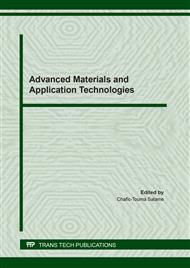[1]
Ahmed, M. (2012). Corrosion Protection of Al Alloys: Organic Coatings and Inhibitors, Recent Researches in Corrosion Evaluation and Protection.
DOI: 10.5772/31983
Google Scholar
[2]
Ali, M. A. (2016). Inhibition of mild steel corrosion in cooling systems by low- and nontoxic corrosion inhibitors. University of Manchester.
Google Scholar
[3]
Anastas, P., & Kirchhoff, M. (2002). Origins, current status and future challenges of green chemistry. Acc. Chem. Res, 686-694.
DOI: 10.1021/ar010065m
Google Scholar
[4]
Ansari, K. R., Quraishi, M. A., & Ebenso, E. (2013). Electrochemical and thermodynamic investigation of diclofenac sodium drug as a potential corrosion inhibitor for mild steel in hydrochloric acid. International Journal of Electrochemical Science, 12860-12973.
Google Scholar
[5]
ASTM International. (2002). Standard Terminology Relating to Corrosion and Corrosion Testing. West Conshohocken.
Google Scholar
[6]
Dwivedi, D., Lepková, K., & Becker, T. (2017). Carbon steel corrosion: a review of key surface properties and characterization methods. RSC Advances.
DOI: 10.1039/c6ra25094g
Google Scholar
[7]
Eddy, N. O., & Ebenso, E. E. (2010). Adsorption and quantum chemical studies on Cloxacillin and halides for the corrosion of mild steel in acidic medium. International Journal of Electrochemical Science, 731-750.
Google Scholar
[8]
Eddy, N. O., & Odoemelam, S. A. (2008). Norfloxacin and Sparfloxacin as corrosion inhibitors for zinc. Effect of concentrations and temperature. Journal of Materials Science, 87-96.
Google Scholar
[9]
Mahdi, A. S. (2014). Amoxicillin as green corrosion inhibitor for concrete reinforced steel in simulated concrete pore solution containing chloride. International Journal of Advanced Research in Engineering and Technology, 99-107.
Google Scholar
[10]
Ladha, D. G., Naik, U. J., & Shah, N. (2013). Investigation of cumin (Cuminum Cyminum) extract as an eco-friendly green corrosion inhibitor for pure Aluminium in acid medium. Journal of Materials and Environmental Science, 701-708.
Google Scholar
[11]
Fajobi, M. A., Fayomi, O. S. I., Akande, I. G., & Odunlami, O. A. (2019). Inhibitive Performance of Ibuprofen Drug on Mild Steel in 0.5 M of H 2 SO 4 Acid. Journal of Bio-and Tribo-Corrosion, 5(3), 79.
DOI: 10.1007/s40735-019-0271-3
Google Scholar
[12]
Fayomi, O.S.I., Akande, I.G. and Nsikak, U., 2019, December. An Overview of Corrosion Inhibition using Green and Drug Inhibitors. In Journal of Physics: Conference Series (Vol. 1378, No. 2, p.022022). IOP Publishing.
DOI: 10.1088/1742-6596/1378/2/022022
Google Scholar
[13]
Fayomi, O. S. I., & Popoola, A. P. I. (2019, December). Corrosion propagation challenges of mild steel in industrial operations and response to problem definition. In Journal of Physics: Conference Series (Vol. 1378, No. 2, p.022006). IOP Publishing.
DOI: 10.1088/1742-6596/1378/2/022006
Google Scholar
[14]
Pathak, R. K., & Mishra, P. (2013). Drugs as Corrosion Inhibitors: A Review. International Journal of Science and Research, 671-677.
Google Scholar
[15]
Vermeirssen, E., Dietschweiler, C., Werner, I., & Burkhardt, M. (2017). Corrosion protection products as a source of bisphenol A and toxicity to the aquatic environment. Water Res, 586-593.
DOI: 10.1016/j.watres.2017.07.006
Google Scholar
[16]
Sheldon, R. (2018). Metrics of Green Chemistry and Sustainability: Past, Present, and Future. ACS Sustain. Chem. Eng, 32-48.
DOI: 10.1021/acssuschemeng.7b03505
Google Scholar
[17]
World Health Organization. (2019). World Health Organization Model List of Essential Medicines. World Health Organization.
DOI: 10.1530/ey.19.13.1
Google Scholar
[18]
Xu, D., Li, Y., Gu, & T. (2016). Mechanistic modeling of biocorrosion caused by biofilms of sulfate reducing bacteria and acid producing bacteria. Bioelectrochemistry, 52-58.
DOI: 10.1016/j.bioelechem.2016.03.003
Google Scholar
[19]
Fayomi, O. S. I., & Akande, I. G. (2019). Corrosion mitigation of aluminium in 3.65% NaCl medium using hexamine. Journal of Bio-and Tribo-Corrosion, 5(1), 23.
DOI: 10.1007/s40735-018-0214-4
Google Scholar
[20]
Fayomi, O. S. I., Akande, I. G., Popoola, A. P. I., & Molifi, H. (2019). Potentiodynamic polarization studies of Cefadroxil and Dicloxacillin drugs on the corrosion susceptibility of aluminium AA6063 in 0.5 M nitric acid. Journal of Materials Research and Technology, 8(3), 3088-3096.
DOI: 10.1016/j.jmrt.2018.12.028
Google Scholar
[21]
Pathak, R. K., Mishra, P. (2016). Drugs as Corrosion Inhibitors: A Review, International Journal of Science and Research, 5, (4), 671-677.
Google Scholar


